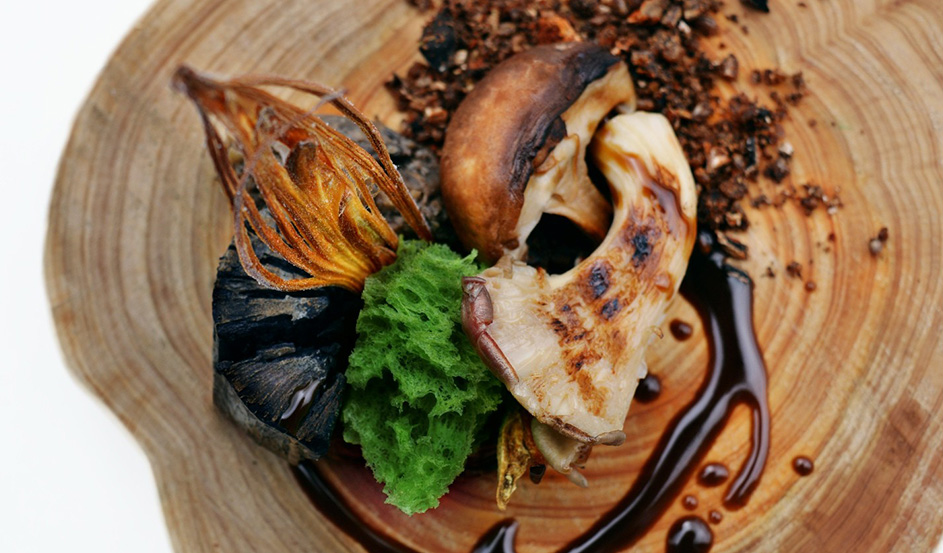
FORAGING FOR INSPIRATION IN A CONCRETE JUNGLE…
Foraging for inspiration in a concrete jungle…
While working away in the kitchen a few weeks ago, a colleague mentioned that they had recently watched an episode of Chef’s Table on Netflix and commented on their amazement at the incredible philosophies and culinary creations of chef Virgilio Martinez of Central Restaurant in Lima. Specifically it was the concept of the chef’s ‘Altitude menu’ which captured my colleague’s imagination- a menu which explores Peru’s biodiversity and celebrates its plethora of unique indigenous ingredients.
But chef Virgilio is not alone in a quest to promote the importance of his land, and it’s ‘terroir’ – a term which has taken on an increasingly important role in the world of gastronomy and the world’s leading restaurants. When asked by the New Yorker magazine to define the archetypal 50 best restaurant David Chang said “It’s opening up in Beijing. It’s a Chinese restaurant by a guy who worked for Adrià, Redzepi, and Keller. He cooks over fire. Everything is a story of his terroir. He has his own farm and hand-dives for his own sea urchins.”
Over the course of the last couple of decades, chefs and foodies from all over the world, have admired the stories and talents of chefs who’s passion for amazing ingredients has led them to all corners of the earth, designing some of the world’s most creative culinary experiences. Just think of the amazing experience offered by Magnus Nilsson in the far reaches of north Sweden. Rene Redzepi has raised the bar in this regard, not only has he studied his own terroir, he has taken this philosophy around the world and explored gastronomic cultures in the most creative and insightful of ways. Even more literal interpretations of the word can be found; Joan Roca, created an oyster dish featuring a distillate of earth (soil). These dining experiences are more than just about food (at least the concept of food as fuel), in many cases they are a celebration of ‘terroir’ and the marriage of great products, culinary skills and creativity. They are unique and individual experiences, ever evolving. Like many young chefs, I would often wonder (and still do) how I relate to these philosophies and how they relate to my own culinary paradigm, most importantly what is my terroir?
This is where chefs must take heed, and be self-aware of what lessons it is that one should take away from another chef. There have been numerous examples of failed gastronomic concepts which try to adopt a culinary philosophy which is not meaningful to them. Countless chef’s have lost their way by incorporating elements into their style and philosophy which are not a natural fit with their character, their abilities or their restaurant’s ‘terroir’. Just think about how the misuse of culinary techniques related to the term ‘molecular gastronomy’ ended up creating a mockery out of some menus. And as for superimposing ideas of locality and seasonality on to a menu, just think about chef Oliver Rowe’s Konstam at The Prince Albert – a restaurant in which all the ingredients were to be sourced from within in the M25/London. The project did not work out and the chef admitted to having deviated from his concept for a whole host of basic ingredients he required for his cuisine and which simply could not be sourced locally. Then there are those restaurant who, wanting to jump on a foraging band wagon, will pepper their menu with foraged goodies (delivered from miles away), as Leah Hyslop mentioned in a review of Simon Rogan’s (former) restaurant Fera at The Claridges Hotel “if you’re fed up with going to restaurants and seeing “foraged” “wild” and “local” sprouting all over the menu like a rash of weeds, blame Simon Rogan… Now, everybody is at this Mother Nature malarkey, even stuffy hotels.”
Misappropriating a culinary concept usually results in the creation of pretentious or ingenuine experiences for the diner, accompanied by food that lacks a genuine sense of belonging. Don’t forget those famous words which inspired the great Ferran Ardia ‘creativity means not copying’, in some way these words led Ferran and his brother Albert towards creating one of the culinary world’s most inspiring gastronomic experiences at elbulli. But aside from inspiring creativity these words are also insightful as they warn chef’s away from simply taking an interesting idea and mindlessly copying it, in turn losing all the meaning which made the idea special and interesting in the first place.
So back to the point; yes there are a small number of restaurants around the world which are blessed to be surrounded by an abundance of beautiful ingredients, which directly influence the chef’s cooking – here I cannot help but think of the 2 Michelin Starred Miyamasou restaurant in Kyoto, led by the original foraging chef Hisato Nakahigashi – he talks about the Japanese philosophy refered to as ‘tsumikasa’, which best translates in to English as ‘hunted with gratitude’ (this sentement has served as inspiration for a dish we created by the same title, see the image above). But what is one to do if they are not blessed with such an environment surrounding their restaurant, where do you think the best French Michelin Star restaurants in London are sourcing their Bresse chickens, Espelette pepper, Bayonne ham and countless other regional specific ingredients from? Can you import your terroir? Is that genuine and in keeping with the philosophy, or is it just good enough?
As a chef based in the city of London, I looked introspectively at my own feelings towards this and how my ‘terroir’ comes to define my culinary outlook. I am firmly of the belief that restrictions/limitations can be a good thing, that they can encourage genuine innovation and creativity, and I particularly feel this way in relation to gastronomy. As creativity can come from abundance, it can also come from scarcity (think again of Faviken’s concept). I began by thinking about what terroir means in a more literal sense; the Oxford Dictionary defines terroir as; ‘the complete natural environment in which a particular wine is produced, including factors such as the soil, topography, and climate’, it also notes that terroir is based on the French, ‘land’, from the medieval Latin word ‘terratorium’. Therefore, in a broader context (and while retaining the element of romanticism which surrounds the word) terroir could be understood as being all the environmental factors which influence the outcome of any given labour of love. In my case the labour of love is designing beautiful dishes and experiences for our diners to enjoy and the locality from which I draw inspiration is the ever vibrant city of London.
A city renowned for its arts, culture, multiculturalism, education, and incredible access to knowledge. A city in which anything is attainable (at the right price). A city which promotes and encourages individuality (more so than most). It is one of a number of cities in the world which has experienced a culinary boom in recent years which has redefined the industry (at least on the outside). I cannot express how influential the exposure to such a wealth of knowledge and creative energy has been on how I approach the design of my menus and general culinary perspective. What I have learnt from disciplines outside my own; from exposure to artists, scientists, academics, designers, mixologist, audio specialists, psychologists, synaesthetes, perfumers, (and the list goes on) have all lead to me defining a personal style driven by an insatiable desire for knowledge which is channelled into my love of gastronomy, delicious food, hospitality and generosity. A brilliant example of this includes a chance meeting over 5 years ago with world renowned Oxford University experimental psychologist Professor Charles Spence (at a seminar organised by The London Gastronomy Seminars group), a meeting which led to one of Kitchen Theory’s most defining collaborations in terms of our approach towards the design of menus, dining experiences and our focus on flavour perception in relation to the senses. London can offer access to the most incredible gastronomic inspiration and knowledge. Kitchen Theory itself was established directly after yours truly attended a talk by Ferran Adria at the launch of the ElBulli retrospective at Somerset House. And even as I write this several dishes on our current menu have the roots of their inspiration hanging on the walls at the Tate Modern and within the vaults of the British Library.
So what about the ingredients that we use on our Gastrophysics Chef’s Table? Let’s start by saying that quality (not in monetary value) and flavour are of prime importance. Like all chefs worth their salt, we love to use the best of fresh British seasonal ingredients, but not all of these are ‘local’ or ‘more sustainable’ just because they are British, so we use them where we can, but it is not always practical or sustainable to do so. We also work hard to keep our menus as sustainable as possible, very little (if any) red meat and carefully selected seafood appear on our menus, (although there is still no agreed upon definition for sustainability – and it really depends on who you ask as to what the answer will be). Finally, we have travelled around the world and are grateful to have had exposure to ingredients that have blown our minds and we want to share these flavours with our guests at the chef’s table. An example would be the Oaxacan mole negro on one of our current dishes – yes you could make it in the UK but I have never tried anything like the mole negro paste we source from a village in Oaxaca, the duck stock that we use with it we make using duck from Creedy Carver (a farm based in Devon). Therefore seasonality, locality and sustainability will always be in mind, but they by no means define us. In the same way that we do not wish to be defined as multisensory experience based solely on our use of a projection mapped table or atomisers to spray aromas at the table.
We define ourselves by creativity, knowledge and all the goodness/inspiration our ‘terroir’ offers. 😉

